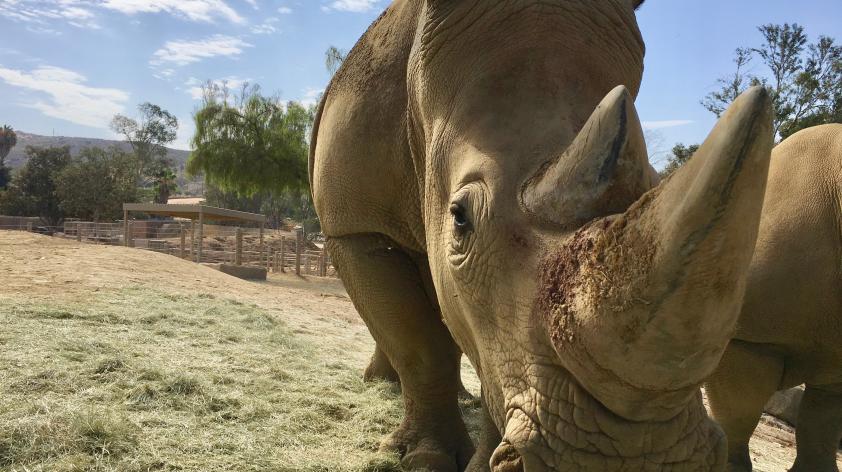
Rescuing Rhinos One Fecal Sample at a Time
Three years have passed since the rhinos at the Rhino Rescue Center (RRC) arrived on a jet from South Africa. Not only did they land on my birthday (what a great “gift”!) but I also knew I was soon to become closely acquainted with them.
My life in the lab quickly became focused on the six female southern white rhinos (SWR) - to be specific I was concentrated on their poop. The six wild rhinos were here on a mission: to save the northern white rhino (NWR) from the brink of extinction. They needed to be reproductively fit for the largest research initiative San Diego Zoo Global has ever taken on!
For the Reproductive Sciences team this means developing innovative assisted reproductive technologies for rhino; including semen collection, artificial insemination (AI), in vitro fertilization, and embryo transfer in an animal nearly 8000x the size of the lab rat; one of the species in which these technologies were originally developed.
Ultimately, developing these techniques for rhinos will allow SWR to serve as surrogate mothers to NWR calves in the future. Over the past three years we have made great strides to achieving this goal. Thanks to the RRC keepers the rhinos have been trained to a chute for regular transrectal ultrasounds. Prior to entering the chute, they have also been trained to poop to clear the way for the ultrasound probe, making regular fecal collections even easier!
Regular ultrasounds allowed the Repro team to time ovulation induction making ovulation a predictable event and this technique has led to three successful AIs and two SWR pregnancies!
Where did the Reproductive Sciences work begin? Well, that brings us back to the rhino poop.
An animal’s poop contains a ton of information and most importantly for us, it is easily accessible. We were interested in the “pregnancy hormone” progesterone excreted in the feces. Before all of the rhinos were trained and the more technical work could begin we needed to know the reproductive status of the females and quick!
As soon as the RRC females arrived the keepers worked diligently to collect a cupful of feces three times a week. The fecal cups traveled to the lab where the feces was dried (fun fact: we have found SWR feces to be composed of about 80% water) for hormone extraction. From the fecal extract, progesterone was measured using a test called a radioimmunoassay or RIA. At first, we knew the 6 females only by ear tag numbers, but quickly each girl’s personality came out and number IDs transitioned to names and even nicknames given by the keepers.
Not only did each female have her own story to tell, but so did her hormones.
Victoria was the first to spark all of our interests with the highest progesterone levels ever recorded from a rhino in our lab. In February ultrasound confirmed Victoria was already a few months pregnant!
With Wallis, a different pattern began to emerge. Her progesterone had a cyclical pattern rising for about 30 or 60 days and then falling and so on. Wallis was exhibiting regular estrous cycles indicating she was ovulating with regularity.
The other four girls - Nikita, Amani, Livia and Helene - all were what we call “flatliners” because their progesterone levels were low and stayed low. This is a phenomenon documented in zoos across the country but we were not expecting to see it in the females brought in from the wild.
Once the rhinos were trained for regular ultrasounds we were able to see that they were growing follicles but not ovulating. To date the Reproductive Sciences lab has analyzed 2,822 fecal samples with no end in sight! With all of the technology now involved in this project, it is amazing to think that it all began with a few cups of rhino poop.













